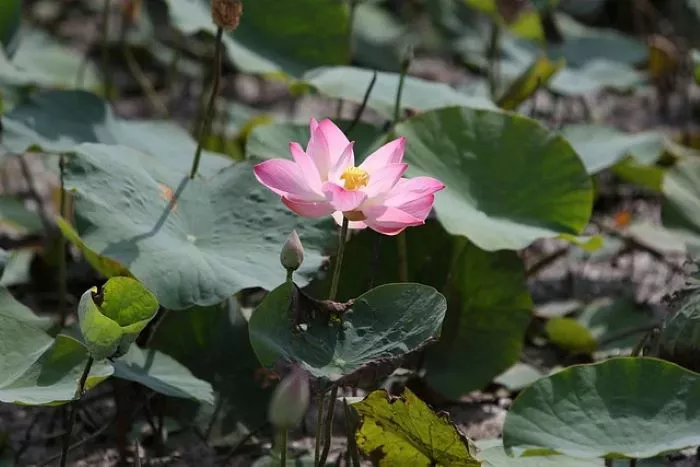The flower that blooms on a lily pad is commonly known as the water lily. Water lilies are aquatic plants that belong to the family Nymphaeaceae. They are known for their beautiful flowers and distinctive round leaves, which float on the surface of ponds, lakes, and slow-moving rivers. This article will explore the characteristics of water lilies, their ecological significance, and their cultural importance.
Characteristics of Water Lilies
Water lilies are easily recognizable due to their large, flat leaves and stunning flowers. The leaves, also known as lily pads, can vary in size, typically ranging from 6 to 12 inches in diameter. They are usually green, but some species have reddish or purple hues. The leaves are designed to float on the water’s surface, allowing the plant to access sunlight for photosynthesis.
The flowers of water lilies are equally impressive. They can be found in various colors, including white, pink, yellow, and blue. The flowers can measure anywhere from a few inches to over a foot in diameter, depending on the species. Water lily flowers usually bloom during the day and close at night, although some species are nocturnal and bloom in the evening. The blooms are often fragrant, attracting pollinators such as bees and butterflies.
Water lilies are perennial plants, meaning they live for several years. They grow from rhizomes, which are thick, horizontal stems that anchor the plant in the sediment at the bottom of the water body. The rhizomes store nutrients and energy, allowing the plant to survive through seasonal changes.
Ecological Significance of Water Lilies
Water lilies play a vital role in aquatic ecosystems. They provide habitat and shelter for various organisms, including fish, amphibians, and insects. The floating leaves create shade, which helps regulate water temperature and reduces algae growth. This shading effect is essential for maintaining a balanced ecosystem in ponds and lakes.
Additionally, water lilies contribute to water quality. Their roots help stabilize sediments and prevent erosion. The plants absorb nutrients from the water, which can help reduce excess nutrient levels that lead to problems like algal blooms. By improving water clarity and quality, water lilies support a healthy environment for aquatic life.
Water lilies also serve as food for various wildlife. Many animals, including ducks and other waterfowl, feed on the leaves and flowers. The seeds of water lilies are also a food source for fish and birds. This interconnectedness highlights the importance of water lilies in sustaining biodiversity.
Cultural Importance of Water Lilies
Water lilies have significant cultural and symbolic meanings in various societies. In many cultures, they represent purity, beauty, and tranquility. The serene appearance of water lilies floating on a calm surface evokes feelings of peace and harmony.
In ancient Egypt, the water lily was a sacred symbol. The blue lotus, or Nymphaea caerulea, was associated with the sun god Ra and represented creation and rebirth. Water lilies were often depicted in ancient art and were used in religious ceremonies.
In Asian cultures, particularly in Buddhism, water lilies symbolize enlightenment and spiritual awakening. The flower’s ability to rise from murky waters and bloom beautifully represents the journey toward enlightenment. This symbolism has made water lilies a popular motif in art, literature, and religious practices.
In modern times, water lilies continue to inspire artists and designers. They are frequently featured in paintings, textiles, and home decor. The iconic works of Claude Monet, particularly his series of water lily paintings, have contributed to the flower’s lasting legacy in the art world.
Growing Water Lilies
For those interested in cultivating water lilies, they can be grown in garden ponds or water features. Water lilies thrive in full sun and require a minimum of six hours of sunlight each day. They prefer still or slow-moving water and can be planted in containers or directly in the pond.
When planting water lilies, it is essential to choose the right variety for your climate and pond size. Some species are better suited for smaller ponds, while others can grow in larger bodies of water. Proper care includes regular fertilization and monitoring water quality to ensure the health of the plants.
Water lilies can also be propagated from rhizomes. When dividing rhizomes, it is important to ensure that each section has at least one growing tip. This method allows gardeners to expand their water lily collection or share plants with others.
Conclusion
In conclusion, the flower that blooms on a lily pad is known as the water lily. These beautiful aquatic plants are characterized by their floating leaves and vibrant flowers. Water lilies play a crucial role in maintaining healthy aquatic ecosystems and have significant cultural meanings across various societies. Their beauty and ecological importance make them a beloved addition to gardens and natural water bodies. Whether admired in a tranquil pond or celebrated in art and culture, water lilies continue to captivate people around the world.


